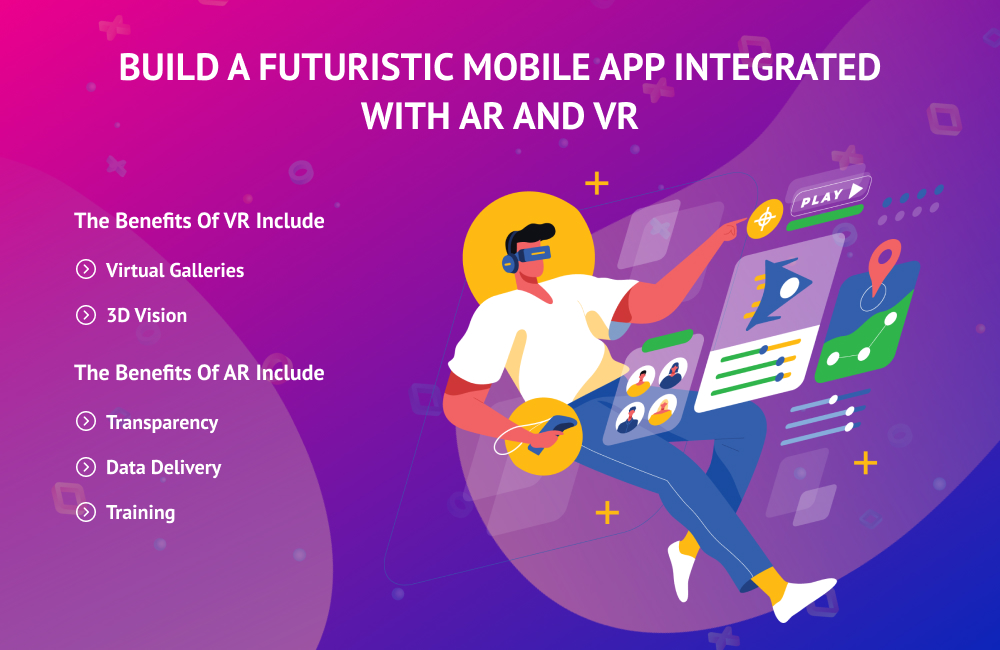The smartphone era excited the entire world. With each passing day, the demand for innovation from tech interactions increases. This has made way for other platforms where users are more engaged and experiences are more immersive. That is right, what we used to perceive to be the future has quickly become reality.
Augmented Reality (AR) and Virtual Reality (VR) concepts that were fancy and farfetched are now here to stay. Mobile app development companies in the USA and technology giants like Apple, Google, Facebook, and Amazon have dedicated themselves to developing new technologies in this realm.
Understanding AR and VR
AR refers to an overlay of technology in the real world, while VR builds a digital (virtual) terrain. In the past, both were primarily associated with the entertainment industry. However, that is not the case anymore.
With today’s tech-savvy consumers, selling products on a simple website is no longer good enough. Instead, modern enterprises need to find ways to create a digital experience that can engage and amuse customers on multiple levels and across a multitude of devices and platforms. While websites and mobile apps are now a staple across the globe, businesses are now investing in building virtual reality and augmented reality ecommerce strategies
Companies that have taken big strides with Augmented Reality include
- Microsoft
- VironIT
- VR Vision Inc
- FundamentalVR
- Apple
Companies that have taken big strides with Virtual Reality include
- Oculus VR (now owned by Facebook)
- HTC Vive
- Unity
Is it necessary to integrate AR and VR tech into B2C mobile applications?
Every new smartphone in the market is equipped with unprecedented AR/VR capabilities. According to Statista, the global AR and VR market will reach an incredible $296.9 billion by 2024. Currently, we have around 2 billion mobile devices that support the AR experience.
AR and VR technology alters how you visualize and use data, improve efficiency, and build a competitive advantage. Using AR and VR, businesses can fulfill vendor and customer demands faster and with greater accuracy. It is not just a transactional thing either. Even in the healthcare industry, the applications are quite fascinating. Today, surgeons can execute their operations more precisely, thanks to these technologies.
The benefits of AR and VR, individually and combined, through mixed reality are getting bigger and better, and are waiting to be seized.
Companies that realize the total worth of augmented and virtual reality will get many things right and stay ahead of the curve. It is time you identified how you can apply AR and VR to your unique business model to address specific challenges and achieve short-term goals. AR and VR are influential tools for increasing sales and boosting revenues.
From a business-customer perspective, cutting-edge technology like this can deliver a convenient virtual user experience, making your customer’s interactions with you quicker, hassle-free, and way more engaging.
Ways in which brands can utilize AR and VR technologies
As competition continues to grow, brands are looking for inventive ways to expand their client base and rethink their business strategies. Most companies are switching to digital platforms to stay ahead. These cutting-edge technologies go beyond gaming and entertainment.
As you read this article, more and more companies are incorporating AR/VR applications into their business. This is happening across industries from education and eCommerce to healthcare and construction, automotive to real estate, IT, fashion, sports, hospitality, and more.
The Benefits of VR Include –
1. Virtual galleries
Factories, auto companies, hotels, product companies, and many others can use this technology to showcase their products and offerings in virtual galleries, delivering life-like user experiences. eCommerce apps are equipped with virtual trial rooms to allow shoppers to try on the apparel or get a glimpse of how a piece of furniture would look in their room.
2. 3D vision
VR-based apps navigate customer engagement because they can offer immersive experiences using 3D images of the products. With this, businesses can enhance client satisfaction and cultivate loyalty, thus improving conversions and expanding their profits.
3. Interactive marketing and branding
VR enables trade players to harness the power of a fantastic blend of technology and photography to promote their products by providing greater interactivity. Moreover, these apps shine better in the crowd and earn an extra winning edge for the brand, thus making them stand tall amongst contenders.
The Benefits of AR Include –
1. Transparency
With AR-based applications, SMEs can present their services and products by supplying an impactful visual adventure to the buyers.
2. Data delivery
AR allows corporations to display to the audience in real-time, data that is relevant to their products. Voluminous, context-based data can be presented in a much more engaging manner via AR.
3. Training
AR apps and devices serve as an effective simulation training tool for employees. It ensures high-tech, immersive activity, which eventually increases their productivity and enhances their efficiency as well.
To ensure your business can leverage the power of augmented and virtual reality correctly, it is necessary to join hands with a dependable technology partner. At QualDev, we specialize in creating advanced AR and VR applications that help your business stay ahead of the curve. QualDev leverages these creative and advanced technologies to enable digital transformation for clients.
For more than ten years, QualDev has been building robust, scalable, enterprise-level mobile apps. Depending on your unique needs, we can create mobile applications with AR and VR technologies from scratch or upgrade your existing app to work seamlessly on any device or platform (phones, tablets, wearables).
Get in touch with our team today to find out more!

